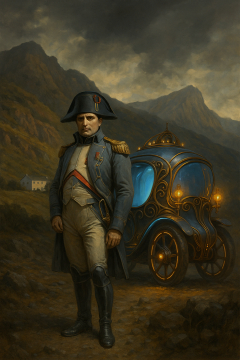The Chariot of Time
It was the fall of 1820. Napoleon Bonaparte was spending his days at Saint Helena, a remote volcanic island in the South Atlantic, where the British had exiled him after his defeat at the Battle of Waterloo. One evening, he wandered alone in the rocky hills near the Longwood House. The wind was sharp, the sky heavy with clouds. He walked often like this: restless, feeling trapped in exile. But today, something unusual caught his eye.
In a small clearing stood a strange carriage. It wasn’t like the wooden carts of his time. This one shimmered. Smooth metal, soft glowing lights, and tiny golden bells chimed gently in the breeze. It looked... inviting. Mysterious. Powerful.
He stepped closer and without thinking, he climbed in. The door closed on its own, and a soft blue light filled the space. A low hum began beneath his feet, rising to a sharp pulse. In a blink, the world outside vanished. When the door opened again, everything had changed.
He was standing in the middle of a strange city—tall glass towers, flashing lights everywhere. Directly ahead was a sleek black building with a glowing sign:
AxionIQ – Building AI solutions that can think and reason.
AxionIQ – Building AI solutions that can think and reason.
Still in his old uniform, Napoleon walked through the glass doors. Inside, people stared. One woman—young, focused, seated in front of glowing screens—looked up.
Melanie: “Can I help you?”
Napoleon: "Pardon me, Mademoiselle. I seem to have arrived somewhere unfamiliar. What year is this?"
Melanie (blinking): "Uh... 2025. And... who exactly are you?"
Napoleon (bowing slightly): "Napoleon Bonaparte, at your service."
Melanie (smirking): "Sure. And I'm Cleopatra."
Napoleon: "No, truly. Emperor of the French. Perhaps you might test me. Ask a question from my life—I assure you, I shall answer precisely."
Melanie (curious, humoring him): "Alright... When and where did you get crowned as the Emperor of France?"
Napoleon: "I crowned myself, in the cathedral of Notre-Dame in 1804. Now—verify it, if you please."
Melanie: "With what? History books?"
She paused, then opened ChatGPT and typed the question.
ChatGPT: “Napoleon Bonaparte crowned himself Emperor of the French at Notre-Dame Cathedral on December 2, 1804.”
Napoleon (eyes widening): "What is this? Some kind of oracle?"
Melanie: "Sort of. It's an AI—trained on all the information that is available to the world. We call it the world-wide web or the internet. It can answer pretty much anything that’s ever been written about."
Napoleon (in awe): "So... my victories, my defeats, my exile—this device knows it all?"
Melanie (grinning): "Pretty much."
Napoleon (leaning in, intrigued): "Then let me try one it cannot answer. What did I tell Joséphine the night before I left for Italy?"
Melanie typed that question, and ChatGPT responded: “Sorry, I do not have information on that.” Napoleon leans back, triumphant and quiet.
Melanie typed that question, and ChatGPT responded: “Sorry, I do not have information on that.” Napoleon leans back, triumphant and quiet.
Napoleon: "Finally, a secret that remains mine."
Melanie: "You know, Napoleon... If there are things only you know—stories never told, thoughts never written—I could change that."
Napoleon (raising an eyebrow): "What do you mean?"
Melanie: "Tell me. Everything. Secrets, reflections, regrets, motivations. Stuff historians never captured. I want the raw version—from you."
Napoleon: “I will tell you my story. Even the parts no one knows. But I do not wish for the world to see me this way”
Melanie smiled and returned to her screen. A Neo4j local Docker container spun up quietly. She set up Neo4j’s MCP server on the Claude Desktop.
Melanie smiled and returned to her screen. A Neo4j local Docker container spun up quietly. She set up Neo4j’s MCP server on the Claude Desktop.
Melanie: “You won’t have to. Let me show you something. Perhaps we can use something called GraphRAG. It would turn your life into a private knowledge graph. This knowledge won’t go anywhere. No internet. Only this machine. Just for you and me. Think of it as a way to build a memory palace from your life, but instead of rooms and tapestries, we use a network of ideas, events, and emotions all linked together like roads between cities.”
Napoleon now convinced, paced the room slowly and began speaking. Melanie typed as fast as she can. Pages became a rich, detailed, and personal document.
She began uploading the document, and asked Claude to create a knowledge graph out of it. Claude parsed them into structured knowledge (entities, events, relationships), and generated cypher queries to load them into the Neo4j instance running locally.
She then connected to Neo4j AuraDB for visualization, and projected the result onto a large screen.
Colorful nodes bloomed like constellations: "French Revolution", "Coronation as Emperor", "Invasion of Russia", "Battle of Waterloo". Relationships formed in real time.
Napoleon (softly): “It is... beautiful!”
Melanie: “It’s your life, told your way. Not judged, not rewritten. And no one else will see it unless you allow it.”
Melanie then typed a question on Claude desktop:
“Can you tell me how Napolean was feeling during his days of exile in Saint Helena? What did he fear the most?”
“Can you tell me how Napolean was feeling during his days of exile in Saint Helena? What did he fear the most?”
Napolean’s eyes widened when he saw the response from Claude. He nodded, eyes misty. For once, he felt understood. Not by people, but by a machine that mirrored his soul.
Melanie: "Now, your story is known to me—not just the conqueror’s, but the man’s."
Napoleon: “You have given me something I never had. A way to be understood.”
